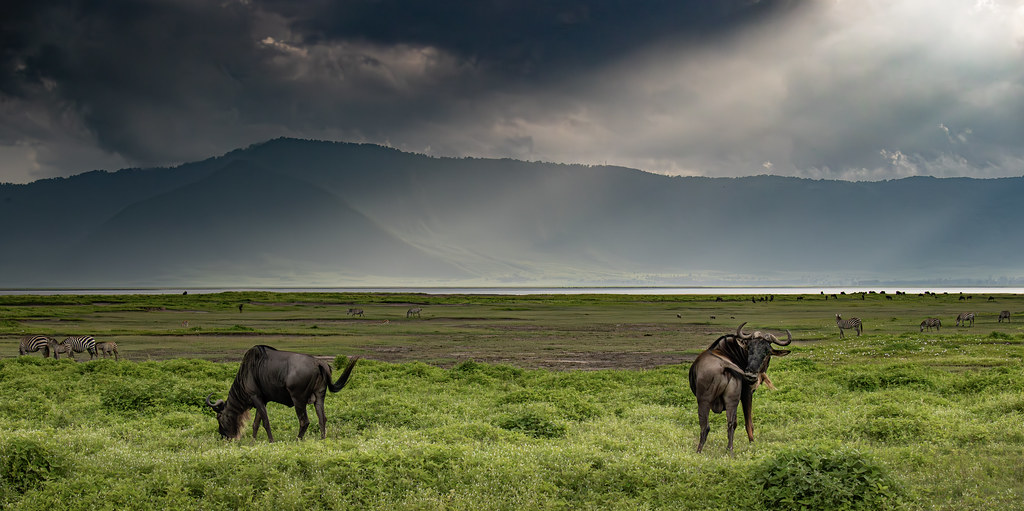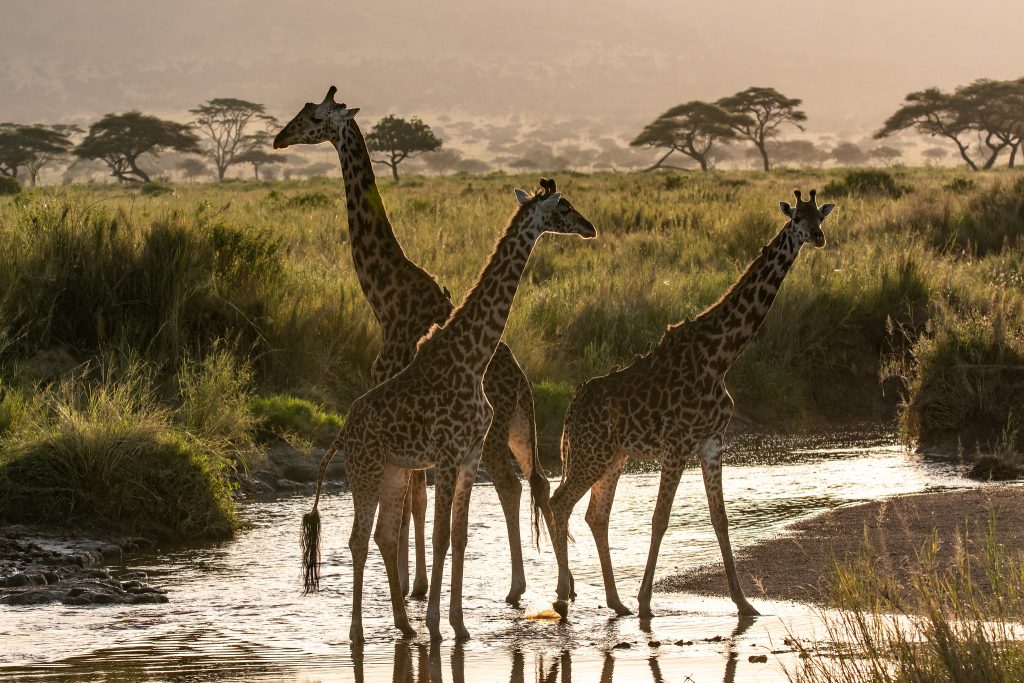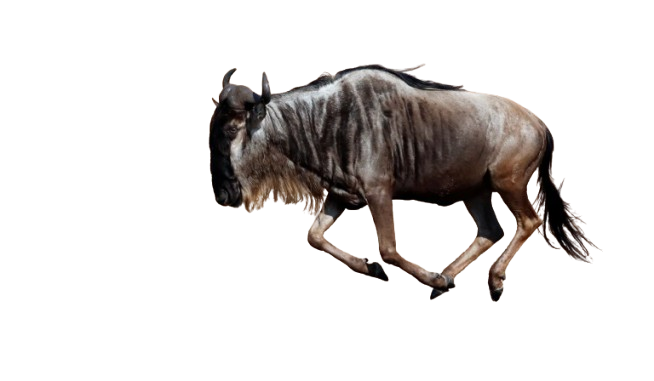Tanzania: Start your Tanzania journey today
Tanzania, a beautiful East African country and indeed a must-visit travel gem, promises a blend of nature and luxury. From the Serengeti’s wildebeest migration to the Ngorongoro’s richer wildlife – enjoy a safari like no other. Get up close to lions, elephants, and zebras in award-winning parks like Serengeti, Lake Manyara, and Tarangire. Conclude your tour with a relaxation on the pristine beaches of Zanzibar. For these and other things, Tanzania should be at the top of every safari-goer’s bucket list.
As many nature lovers can’t skip Tanzania on their African safari, we pride ourselves to be guiding clients to explore the beauty of this beautiful country. Its countless natural attractions and unique culture make it feasible for every safari kind – be it a honeymoon escape, a family trip, or a romantic getaway. Our guides and experts are constantly bringing new, booming options to put our valuable clients ahead of the game before others start to step in. For that reason, we are your complete guide, and all the information that you may need to plan your Tanzania tour is at your fingertips – and just a call or an email away.
The best time to visit Tanzania
Tanzania is good year-round, but June – October is always the best. Dry air, cool temperature, and clear skies make it easy for hikers and animal lovers. This season coincides with the peak of wildebeest migration, when the herds cross the mighty Mara River. Dry season comes with challenges like high rates and crowded destinations, but it’s worth it.
March through May is always wet, thus recording the lowest number of visitors. However, it’s good for birding and photographic safaris.
November to February is great for low crowds and discounted rates. Short rains occur, but always during the night. Climbing is ideal during this time as the trails are scenic and there are no crowds.
Top Destinations in Tanzania
Tanzania is home to a myriad of tourist destinations – including wildlife-packed parks and game reserves, mirror-like lakes, towering mountains, ancient historical sites, metropolitan cities and vibrant towns, museums, and beautiful beaches. All are the best destinations, but for many visitors, the following are the top destinations:
Serengeti National Park
Serengeti is one of the premier wildlife sanctuaries in the world. It’s known for hosting the largest concentration of animals and for the wildebeest migration –, the one-of-a-kind event happening annually in the Serengeti-Mara ecosystem.
The Serengeti is 14,760 square kilometers big and lies in the north of the country, or the northern circuit as many refer. The Park is easily accessible from Arusha, a bustling safari town in Tanzania, by either road or air.
Driving is the most common way to reach the Serengeti from Arusha. While it takes 6-7 hours, it’s more rewarding since the route takes the highland road through the Ngorongoro Highlands. It’s a drive-in safari with optional stops at the Meserani Snake Park to watch reptiles, or at one of the Maasai villages.
For those demanding a quick transfer, flying to the Serengeti is the best option. You can fly from Arusha Airport (ARK) to one of the Serengeti’s airstrips. Your landing airstrip depends on where you’ll be staying. There are seven airstrips to choose from, including Seronera, Kogatende, Serengeti Kusini, Lobo, Kirawira, Sasakwa Grumeti, and Fort Ikoma.
The wildebeest migration, or simply the Great Migration, is one of the spectacular features to behold. Each year, over 1.5 million wildebeest, accompanied by thousands of zebras and gazelles, migrate from south of the Serengeti to the north. This event comes with astonishing wonders like the calving season, Grumeti crossings, and the famous Mara River crossings. The calving season happens from January through February, where about half a million calves are brought into life in the fertile soils of the southern Serengeti and Ndutu plains.
Grumeti and Mara River crossings occur from May to June and from July to September, respectively. The latter is famous and more dangerous than the former. During this season, wildebeest migration is at its pinnacle as giant herds gather on one side of the Mara River waiting for the right time to cross. This scene, if it happens to be viewed, is one of a kind. Thousands of nature lovers come to watch the brave animals taking on the crocodile-infested waters of the great Mara River. Planning is key if you want to witness the wildebeest migration since it’s unpredictable. It’s, therefore, more important to get in touch with your tour operator.
The Serengeti is also home to the Big Five. If ticking off these creatures is your wish, include Serengeti in your bucket list. Here, you can see the Big Five, many lions as you ride, and trek the Great Migration – though this depends on the timeframe. The Park is the host of the world’s lion population. Lions prefer open grasslands – and Serengeti, like what its name means in the Maasai’s Maa language – is the land of ‘endless plains’. Elephants, buffalo, and leopards are abundant, though care is required to spot leopards due to their elusive nature. The number of black rhinos is promising, and the chances of encountering this heavy, historical animal are good.
And there are plenty of other animals. One way you encounter a giraffe, the other way you meet a herd of antelopes. There are also cheetahs, hyenas, dik-diks, jackals, elands, warthogs, and so much more. Serengeti is also the home of over 500 bird species, which range from big ones like ostriches and Kori bustards to small ones like ashy starlings. If seeing birds makes a good trip for you, don’t forget to bring a good camera and binoculars.
Resident wildlife makes wildlife safaris in the Serengeti year-round. Anytime you visit this park, you’re guaranteed to spot wildlife, birds, and its varied landscapes.
Ngorongoro Conservation Area
Adjacent to the Serengeti in the east is a spectacular conservation area – the Ngorongoro Conservation Area. This gem promises the views of the Big Five games in its masterpiece, Ngorongoro Crater – a wonderful caldera covering 264 square kilometers. Small as it is, this crater harbors the most diverse wildlife, and it’s a complete, self-sustaining ecosystem. As a result, it’s easier to spot wildlife on its crater floor than it is in the Ngorongoro Conservation Area. The Maasai also make the NCCA appealing from a cultural perspective.

Kilimanjaro National Park
No other mountain in Africa beats Kilimanjaro in terms of height. It’s 5,895 meters above sea level and, of course, the highest peak in Africa. This iconic, dormant volcano is a challenging hike worth a try because no special mountaineering skills are needed to conquer it.
Every year, about 65,000 hikers start the walk to the summit – but only a few of them succeed. To succeed on your Kilimanjaro, it’s important to research and take into account the basics required. Train, train again and again. The major drawback facing many climbers is altitude, which can be avoided by attempting other peaks like Mount Meru.
A Kilimanjaro hike often rewards hikers with the views of glaciers and snows, sunrise, hiking experience, and the thrill of being on the roof of Africa. Hiking can follow any of the seven routes: Marangu, Machame, Lemosho, Rongai, Umbwe, Shira, and Northern Circuit.
Climbing Kilimanjaro is great throughout the year. But March, April, and May are so wet. These months receive heavy rains, and we advise avoiding them. June to October is the ideal time for climbing Kilimanjaro, but if you’re okay with large crowds. November to February is the right time to avoid both the crowd and heavy rains.
Tarangire National Park
Tarangire National Park is remote and quiet, unlike other safari parks in the North. As a result, wildlife is undisturbed, and it has lush landscapes worth it. The main draw cards are its large elephant population, striking landscape with a backdrop of escarpment, and animal migration.
Seeing massive herds of elephants is a tradition here. In season, water is scarce, but not in the Tarangire River. As a result, large animals like elephants, buffalo, giraffes, lions, and leopards move to its riverbanks, making wildlife viewing very easy. Night game drives are permitted in Tarangire. Find out if your lodge organizes this wonderful safari experience.
Lake Manyara National Park
The unique tree-climbing lions only exist in Lake Manyara in Tanzania and Uganda’s Queen Elizabeth National Park. Their ability to climb even upright trees is said to have evolved from avoiding insects and heat. It’s normal to encounter an adult lion panting on an acacia branch during the afternoon.
If you stare at the shores of Lake Manyara from a distance, you’ll notice something. This soda lake appears pink. Why? – due to the presence of pink flamingos. The lake is also home to aquatic species like fish and many others.
Venture into the wilderness to search for elephants, buffalo, giraffes, wildebeests, and zebras. Or explore the forests to see primates like vervet monkeys, baboons, and blue monkeys. An airwalk in Lake Manyara’s canopy is an incredible experience. It’s so unique as it gives you a bird’s eye view of the park – something to wind up your day.
Nyerere National Park
Nyerere National Park (formerly Selous Game Reserve) is the largest park in the country. It spans 30,893 square kilometers. Unlike popular parks in the North, where overcrowding can be a problem, Nyerere never gets crowded. Yet, it hosts the most diverse wildlife, including an incredible lion population, buffalo, elephants, African wild dogs, leopards, and giraffes. Photographers can get the perfect photo here as the vegetation is always green.
Ruaha National Park
Located in the South, next to Nyerere, Ruaha is another lesser-known wildlife park. Usually combined with Nyerere in many safari packages, this park will complement your safari with wildlife views of lions, cheetahs, and wild dogs.
It’s home to a large population of elephants. These huge, grey giants are seen in large groups. Apart from elephants, there are other animals too, including wildebeests, buffalo, giraffes, zebras, and hyenas.
Types of Tanzania safaris
Apart from hosting wonderful wildlife, Tanzania offers unique beach holidays on its semi-autonomous region of Zanzibar. This archipelago is not only home to pristine beaches but also a historical hub and cultural melting pot.
You can relax at a beachfront resort in famous beaches like Kendwa and Nungwi, or pick the less-known islands of Pemba and Mafia. Not afraid of water? Dive at one of the best dive sites in Mnemba Atoll, Mafia, or Kizimkazi.
Tanzania safaris have different tastes depending on what you want to explore and your budget. It also depends on who you’re traveling with – spouse, kids, or alone. All these matters are considered when choosing a Tanzania safari.
Tanzania family safaris
Imagine having your family in a safari jeep in the Serengeti, sharing a wildlife sighting. Family safaris are becoming a tradition to uncover the wonders of Tanzania. Best destinations for families include Serengeti and Ngorongoro, where wildlife exists in abundance. Families can also visit Ruaha and Nyerere in southern Tanzania to explore untouched wildlife.
Honeymoon safaris
It’s always interesting to kickstart your marriage with a voyage around the globe. And of course, Tanzania can make your honeymoon trip unforgettable. Whether you would like to stay in the calm, exquisite beaches of Zanzibar or top-notch lodges and camps in Tanzanian wildlife parks, we promise you won’t regret it.
Hiking safaris
If hiking is your thing, we’ve got you covered. Kilimanjaro awaits you. You don’t need to be a mountaineering expert to beat this summit because it’s not a technical climb. Besides Kilimanjaro, Tanzania boasts Mount Meru, Africa’s fifth-highest peak, and Ol Doinyo Lengai, the only active volcano secreting carbonatite lava. Other mountains include the Udzungwa Mountains, Mount Hanang, and the Usambara Mountains.
Cultural tours
Tanzania boasts over 120 ethnic groups, each with unique traditions, languages, and beliefs. The Maasai have survived alongside dangerous predators like lions in the Ngorongoro Conservation Area. They’re welcoming and usually very happy to host visitors. Their unique traditional dance and dressing style speak volumes about Tanzanian culture.
On the other side of the coin are the Hadzabe bushmen, living in the forests of Lake Eyasi. They neither grow crops nor keep livestock. Their lives depend on hunting and gathering. However, they’re humble to visitors.
There’s much to learn about Tanzanian culture. Every tribe is unique, and your visit will make an incredible impact. It’s your choice to decide which tribe you should visit.
Photographic safaris
Seasoned photographers can get perfect pictures in Tanzania. A photographic safari is just like a normal wildlife safari, only that it’s private and self-paced. You hire a professional driver who’ll take you through a picturesque setting for your shots.
Great Migration safaris
These safaris are available in the Serengeti only. They’re special packages for anyone dreaming of trekking the Great Migration. The wildebeest migration is always unpredictable – timing is key, though it depends on what you want to experience. Major events include the Grumeti River crossings (June – July), the Mara River crossings (July – September), and the calving season (January – March).
Start Planning
We are just a call away! Every visitor is unique, and we don’t have one-size-fits-all itineraries. Upon receiving your call or email, we walk you through the stages to organize your dream safari package. If you’re ready to plan, drop us a call and let’s plan begin.

